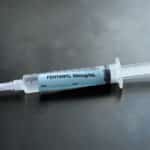Fentanyl test strips are an easy and inexpensive form of drug testing that can tell you if your drug supply contains fentanyl or one of its variations/fentanyl analogs, such as the potent carfentanil.
To use a fentanyl test strip, you dip the strip in a mixture of water and drug sample and then wait a few minutes for the results.
How To Use Fentanyl Test Strips
Fentanyl test strips are relatively easy to use. You simply need to follow these four steps:
- Dissolve a small amount of the drug in some sterile water and mix well.
- Dip the blue end of the test strip into the liquid for about 15 seconds. Make sure the liquid hits the wavy lines on the test strip.
- Remove the test strip and lay it on a flat, clean surface. Wait anywhere from 1-5 minutes.
- Check the test results. One red line means it detected the presence of fentanyl in the drug and two red lines mean the test found no fentanyl. If no line appears, try the test again.
A positive test result can make a positive change in overdose risk behavior, prevent overdoses in general, and cause people to practice more harm reduction strategies like taking drugs more slowly, taking a lower dose, and using drugs with another person around.
Why Use Fentanyl Test Strips?
According to the Centers for Disease Control and Prevention (CDC), 13% of Americans have started or increased drug use since the onset of the COVID pandemic in 2020.
Illicit drugs that are bought off the street pose a risk to drug users because you simply never know what you’re going to get. Street drugs like heroin, methamphetamine/MDMA, and cocaine are often cut or adulterated with dangerous synthetic opioids like fentanyl.
Fentanyl test strips are the only way you can detect fentanyl or fentanyl analogs in purchased street drugs. These test strips are seen as an effective harm reduction strategy that can reduce the risk of overdose deaths related to fentanyl and synthetic opioids.
The tests can be used on injectables, pills, or powders.
While the strips have been proven to be quite accurate, they may not detect every relative of fentanyl and you may still experience a drug overdose even if the test had a negative result.
Fentanyl Overdose
Whether you use the test strips or not, it is important to know what a fentanyl overdose looks like. Getting help sooner rather than later can save a life.
Signs of a fentanyl overdose may include:
- struggling to breath
- pinpoint pupils
- blue lips and/or nails
- pale, clammy skin
- extreme sleepiness
- dizziness
- nausea and vomiting
- decreased heart rate
- loss of consciousness
If someone experiences an opioid overdose, call 911 immediately and wait for first responders. While waiting, if you have access to naloxone (Narcan) and are trained to use it, now is the time. It can reverse the effects of a fatal overdose.
Where To Find Fentanyl Test Strips
Most states have a Department of Health/Department of Public Health and an overdose prevention or harm reduction organization that provides fentanyl test strips to the local community.
If your community has a syringe services program, you’ll likely find fentanyl test strips there as well. Even your healthcare provider may distribute them or at least know where you can find a test kit.
Google Search
If you have access to a computer, a simple Google search of “fentanyl test strips” and the name of your state will also give you lots of information on where you can find tests near you.
SAMHSA
Calling the national SAMHSA hotline or your local state substance abuse hotline can also be a good resource for drug testing information.
If you live with opioid addiction or another substance use disorder, we can help. To learn about our outpatient treatment options, please contact us today.
Sources
- Centers for Disease Control and Prevention (CDC) — Mental Health, Substance Use, and Suicidal Ideation During the COVID-19 Pandemic
- Illinois Department of Human Services — IDHS/SUPR Practice Recommendations for Drug and Fentanyl Testing
- Minnesota Department of Health — Fentanyl Test Strips to Prevent Drug Overdose
Written by
Northeast Addition Editorial Team
©2024 Northeast Addition Center | All Rights Reserved
This page does not provide medical advice.


